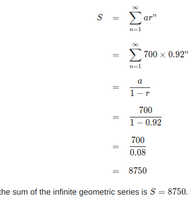amathproblemthatneedsolve
Junior Member
- Joined
- May 12, 2019
- Messages
- 189
I went back and had a look what I posted is all the information given. This is confusing!This is a terrible question because the problem (at least as stated) gives no clue about how much was there to begin with.
So, as tkhunny hinted in post #2, the question (at least as stated) is technically unanswerable.
Thus, the first thing to do is to go back to the statement of the problem and see if you missed something.
If not, you will have to guess what the question means. My guess is that it is asking you to assume that, approximately, everything that is there is in the process of being extracted. So the total there originally is equal to what was extracted before mining ceased and what could be extracted if mining continued until the amount left was approximately zero. (You cannot get to zero by 8% reductions, but a balance below 10 would give a total accurate to considerably better than 1% given that total extraction is already in the thousands.)



